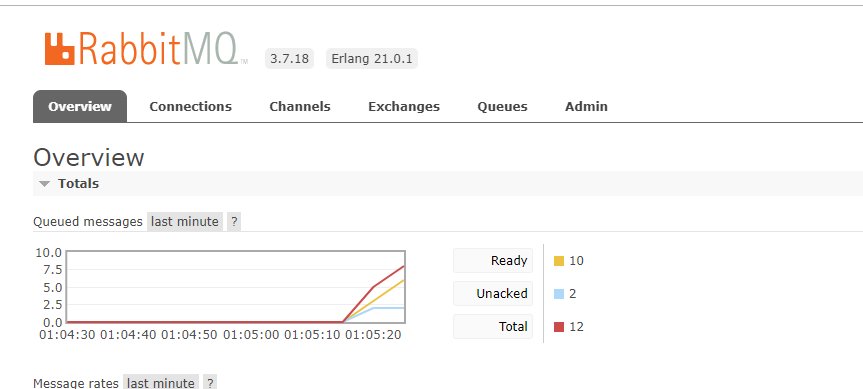新建 RabbitMQProducer项目后,添加依赖
<dependency>
<groupId>org.springframework.boot</groupId>
<artifactId>spring-boot-starter-amqp</artifactId>
<version>2.1.4.RELEASE</version>
</dependency>添加配置类 MQConfig
import org.springframework.amqp.core.Exchange;
import org.springframework.amqp.core.Queue;
import org.springframework.amqp.core.TopicExchange;
import org.springframework.amqp.rabbit.connection.CachingConnectionFactory;
import org.springframework.amqp.rabbit.connection.ConnectionFactory;
import org.springframework.context.annotation.Bean;
import org.springframework.context.annotation.Configuration;
@Configuration
public class MQConfig {
// @Bean
// public ConnectionFactory connectionFactory(){
// return new CachingConnectionFactory();
// }
//
// @Bean
// public RabbitAdmin rabbitAdmin(){
// return new RabbitAdmin(connectionFactory());
// }
@Bean
public Exchange bootExchange(){
return new TopicExchange("BOOT-EXCHANGE-1", true, false);
}
@Bean
public Queue bootQueue(){
return new Queue("boot.queue1", true);
}
}添加po类 user
import java.io.Serializable;
public class User implements Serializable{
/**
*
*/
private static final long serialVersionUID = 1L;
private String userName;
private String password;
public User(String userName, String password) {
super();
this.userName = userName;
this.password = password;
}
public String getUserName() {
return userName;
}
public void setUserName(String userName) {
this.userName = userName;
}
public String getPassword() {
return password;
}
public void setPassword(String password) {
this.password = password;
}
@Override
public String toString() {
return "User [userName=" + userName + ", password=" + password + "]";
}
}添加发送类 MQSender
import org.springframework.amqp.core.Message;
import org.springframework.amqp.core.MessageProperties;
import org.springframework.amqp.rabbit.connection.CorrelationData;
import org.springframework.amqp.rabbit.core.RabbitTemplate;
import org.springframework.beans.factory.annotation.Autowired;
import org.springframework.stereotype.Component;
import cn.syf.rabbitmq.po.User;
import java.util.Date;
import java.util.Map;
@Component
public class MQSender {
@Autowired
private RabbitTemplate rabbitTemplate;
final RabbitTemplate.ConfirmCallback confirmCallback= new RabbitTemplate.ConfirmCallback() {
public void confirm(CorrelationData correlationData, boolean ack, String cause) {
System.out.println("correlationData: " + correlationData);
System.out.println("ack: " + ack);
if(!ack){
System.out.println("异常处理....");
}
}
};
final RabbitTemplate.ReturnCallback returnCallback = new RabbitTemplate.ReturnCallback() {
public void returnedMessage(Message message, int replyCode, String replyText, String exchange, String routingKey) {
System.out.println("return exchange: " + exchange + ", routingKey: "
+ routingKey + ", replyCode: " + replyCode + ", replyText: " + replyText);
}
};
//发送消息方法调用: 构建Message消息
public void send(Object message, Map<String, Object> properties) throws Exception {
MessageProperties mp = new MessageProperties();
//在生产环境中这里不用Message,而是使用 fastJson 等工具将对象转换为 json 格式发送
Message msg = new Message(message.toString().getBytes(),mp);
rabbitTemplate.setMandatory(true);
rabbitTemplate.setConfirmCallback(confirmCallback);
rabbitTemplate.setReturnCallback(returnCallback);
//id + 时间戳 全局唯一
CorrelationData correlationData = new CorrelationData("1234567890"+new Date());
rabbitTemplate.convertAndSend("BOOT-EXCHANGE-1", "boot.save", msg, correlationData);
}
//发送消息方法调用: 构建Message消息
public void sendUser(User user) throws Exception {
rabbitTemplate.setMandatory(true);
rabbitTemplate.setConfirmCallback(confirmCallback);
rabbitTemplate.setReturnCallback(returnCallback);
//id + 时间戳 全局唯一
CorrelationData correlationData = new CorrelationData("1234567890"+new Date());
rabbitTemplate.convertAndSend("BOOT-EXCHANGE-1", "boot.save", user, correlationData);
}
}用单元测试来测试
import org.junit.Test;
import org.junit.runner.RunWith;
import org.springframework.beans.factory.annotation.Autowired;
import org.springframework.boot.test.context.SpringBootTest;
import org.springframework.test.context.junit4.SpringRunner;
import cn.syf.rabbitmq.po.User;
import cn.syf.rabbitmq.sender.MQSender;
@RunWith(SpringRunner.class)
@SpringBootTest
public class RabbitMqApplicationTests {
@Autowired
private MQSender mqSender;
@Test
public void contextLoads() {
String msg = "hello spring boot";
try {
for (int i = 0; i < 15; i++) {
try {
Thread.sleep(1000);
} catch (InterruptedException e) {
e.printStackTrace();
}
//mqSender.send(msg + ":" + i, null);
mqSender.sendUser(new User("anqi", "25"));
}
} catch (Exception e) {
e.printStackTrace();
}
}
}生产者配置信息:
spring.rabbitmq.host=localhost
spring.rabbitmq.port=5672
spring.rabbitmq.username=admin
spring.rabbitmq.password=123456
spring.rabbitmq.virtual-host=admin
spring.rabbitmq.connection-timeout=15000
#开启 confirm 确认机制
spring.rabbitmq.publisher-confirms=true
#开启 return 确认机制
spring.rabbitmq.publisher-returns=true
#设置为 true 后 消费者在消息没有被路由到合适队列情况下会被return监听,而不会自动删除
spring.rabbitmq.template.mandatory=true生产者项目已经写好了,接下来写消费者项目RabbitMQConsumer
添加跟上个项目一样的依赖 添加一样的po类,这里就不copy代码了,
添加接收类MQReceiver
import com.rabbitmq.client.Channel;
import cn.syf.rabbitmq.po.User;
import org.springframework.amqp.core.Message;
import org.springframework.amqp.rabbit.annotation.*;
import org.springframework.amqp.support.AmqpHeaders;
import org.springframework.messaging.handler.annotation.Headers;
import org.springframework.messaging.handler.annotation.Payload;
import org.springframework.stereotype.Component;
import java.io.IOException;
import java.util.Map;
@RabbitListener(bindings = @QueueBinding(value = @Queue(value = "boot.queue1", durable = "true"), exchange = @Exchange(value = "BOOT-EXCHANGE-1", type = "topic", durable = "true", ignoreDeclarationExceptions = "true"), key = "boot.*"))
@Component
public class MQReceiver {
@RabbitHandler
public void onMessage(Message message, Channel channel) throws IOException {
try {
Thread.sleep(5000);
} catch (InterruptedException e) {
e.printStackTrace();
}
long deliveryTag = message.getMessageProperties().getDeliveryTag();
// 手工ack
channel.basicAck(deliveryTag, true);
System.out.println("receive--1: " + new String(message.getBody()));
}
@RabbitHandler
public void onUserMessage(@Payload User user, Channel channel, @Headers Map<String, Object> headers)
throws IOException {
try {
Thread.sleep(5000);
} catch (InterruptedException e) {
e.printStackTrace();
}
long deliveryTag = (Long) headers.get(AmqpHeaders.DELIVERY_TAG);
// 手工ack
channel.basicAck(deliveryTag, true);
System.out.println("receive--11: " + user.toString());
}
}消费者配置信息:
spring.rabbitmq.host=localhost
spring.rabbitmq.virtual-host=admin
spring.rabbitmq.username=admin
spring.rabbitmq.password=123456
#设置消费端手动 ack
spring.rabbitmq.listener.simple.acknowledge-mode=manual
#消费者最小数量
spring.rabbitmq.listener.simple.concurrency=1
#消费之最大数量
spring.rabbitmq.listener.simple.max-concurrency=10
#在单个请求中处理的消息个数,他应该大于等于事务数量(unack的最大数量)
spring.rabbitmq.listener.simple.prefetch=2接来了先运行消费者项目,再运行生产者单元测试方法,在rabbitMQ manager 就会看到

我们看到Unacked始终都是2,在完成中的消息队列只有2个,达到了我们期待的效果,限流的目的已经实现。
最后
以上就是发嗲大门最近收集整理的关于springboot + rabbitMQ 消费端限流限流的全部内容,更多相关springboot内容请搜索靠谱客的其他文章。
本图文内容来源于网友提供,作为学习参考使用,或来自网络收集整理,版权属于原作者所有。








发表评论 取消回复